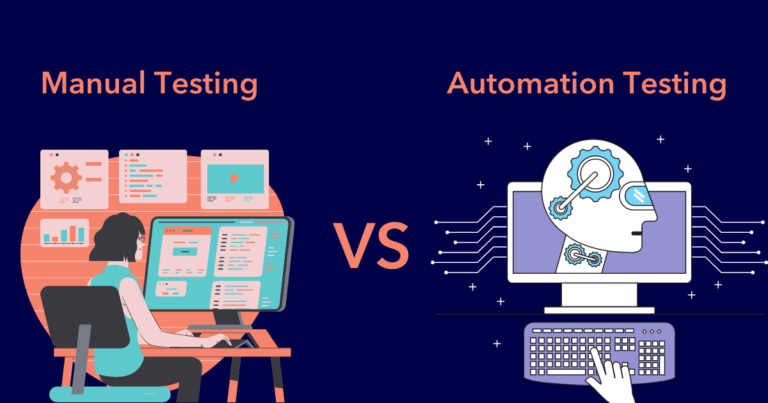Human error, the increasingly feared and famous mistake, has become unjustifiable, especially in the digital world where a simple button press is irreversible. However, in software development, quality assurance (QA) is a process that ensures applications function as intended, providing a seamless user experience.
While automated testing has grown in popularity due to its speed, efficiency, and scalability, manual testing still holds an irreplaceable place in QA. The human element in manual testing brings a unique perspective that automated tools simply cannot replicate. Manual testing is irreplaceable in maintaining software quality, from catching subtle issues to understanding user behaviors.
In this blog, we invite you to navigate the enduring value of manual testing and why it remains a vital component of the modern QA process. Let’s start!
The Rise of Automated Testing in Development
Automation testing has become a cornerstone of QA due to its ability to perform repetitive tests quickly, accurately, and consistently. It excels in scenarios where tests need to be run frequently, such as regression testing, performance testing, and load testing.
Automated tools are also well-suited for handling large volumes of data, executing tests across multiple platforms, and providing rapid feedback, making them indispensable in continuous integration/continuous deployment (CI/CD) pipelines.
However, despite its many advantages, automated testing has some limitations. For example, one limitation is its dependency on pre-defined scripts, which can be fragile and lack flexibility, particularly in dynamic systems. Without human intervention, these scripts cannot adapt to unexpected changes (Thummalapenta et al., 2012).
Automation is ideal for verifying that software works as expected under specific conditions. Still, it lacks the flexibility, intuition, and judgment that human testers bring to the table. In this context, manual testing came into play, adding a crucial layer of depth and nuance to the QA process.
The Irreplaceable Value of Manual Testing
Manual testing excels at adapting to changes on the fly. That’s why they will never disappear or become irreplaceable, especially if you outsource to skilled teams from Jala Soft, one of the top nearshore companies in the market. Now, it’s time to delve into some issues you can detect through a manual process.
- Proven Methods for Detecting Subtle Errors in QA Testing
One of the strengths of manual testing is its ability to detect subtle issues that automated tests might miss. Human testers can explore an application from a user’s perspective, navigating through the software in ways that are not predefined. This exploratory approach allows testers to identify edge cases, usability issues, and unexpected behaviors that automation might overlook.
For instance, only manual testers can notice visual discrepancies, such as misaligned text, poor color contrast, or minor UI glitches that affect the overall user experience. These issues, while not necessarily causing functional failures, can still impact how users perceive the quality of your software. In contrast, automated tests, focused on functional validation, are often not designed to catch such subtleties, making manual testing an essential complement to automation.
- The Importance of Understanding User Experience and Usability
The human element in control is the best option for evaluating an application’s user experience (UX) and usability. While automated tests can validate that the software performs correctly, they cannot assess how intuitive or user-friendly the interface is.
Human testers can provide feedback on the look and feel of the application, identify confusing navigation, and highlight areas where the user journey could be improved.
Moreover, manual testing allows testers to put themselves in the shoes of the end-user, experiencing the software as it would be used in real life.
This empathetic approach helps identify pain points that may not be immediately apparent from a purely functional perspective. For example, manual testers can uncover issues related to accessibility, such as difficulties faced by users with disabilities, which automated tests are not equipped to detect.
- The capacity of Evaluating Complex Scenarios and Contextual Testing
Software applications often operate in complex environments with varying user inputs, configurations, and external dependencies. Manual testing is particularly valuable in scenarios where context and human judgment are needed to navigate these complexities. Human testers can adapt to changing conditions, make decisions on the fly, and explore scenarios that automated tests are not programmed to handle.
For example, in a multi-step workflow with numerous branching paths, manual testers can explore how different combinations of actions affect the application. They can also test how the software interacts with other systems, considering factors like network latency, data quality, and real-time user behavior. This contextual testing ensures that the software functions well in various real-world situations beyond the controlled conditions of automated tests.
- Unparalleled Adaptability for Changing Requirements
Software development is inherently iterative, with requirements that evolve over time based on feedback, market changes, or new business goals. Manual testing offers the flexibility to adapt quickly to these changes, testing new features or modifications as they are introduced. While automated tests require scripts to be updated whenever the software changes, manual testers can adjust their approach immediately, providing rapid feedback on new or altered functionality.
This adaptability is especially important during the early stages of development or when exploring new, uncharted features. Manual testers can quickly assess whether new additions align with the intended user experience and identify any unforeseen issues. Their insights can guide developers in making necessary adjustments before formalizing tests through automation.
- The Role of Human Intuition and Insight to Detect Complex Software Issues
One of the most significant advantages of manual testing is the human insight and intuition it brings to the QA process. Human testers can question assumptions, think creatively, and use their experience to identify potential problem areas. This intuition allows them to go beyond the expected and test the unexpected, revealing vulnerabilities that automated tests might miss.
For instance, a manual tester might sense that a particular workflow could confuse users or that a rarely-used feature might not receive enough attention during automated testing. By leveraging their domain knowledge and critical thinking skills, manual testers can provide valuable feedback that goes beyond pass/fail results, offering deeper insights into how the software can be improved.
How to Balance Manual and Automated Testing in QA
While manual testing offers numerous benefits, it is not a replacement for automation. Instead, the most effective QA strategies leverage a balanced approach that combines the strengths of both manual and automated testing. This integrated approach ensures comprehensive coverage, with automated tests handling repetitive, high-volume tasks and manual tests providing the human perspective needed for nuanced assessments.
To achieve this balance, your organizations should consider the following best practices:
- Identify the Right Tests for Automation:
Use automated testing for repetitive, time-consuming tasks that require consistency and speed, such as regression tests, performance tests, and smoke tests. Automation is ideal for tests that need to be run frequently or involve large datasets.
- Focus Manual Testing on High-Value Areas: Allocate manual testing efforts to areas where human insight is most valuable, such as exploratory testing, UX assessments, and complex scenario evaluations. Manual testing should complement automation by focusing on tests that require creativity, intuition, or human judgment.
- Foster Collaboration Between Testers: Encourage collaboration between manual and automated testers, allowing them to share insights, strategies, and feedback. This collaboration can help ensure that all aspects of the software are thoroughly tested, with each approach informing and enhancing the other.
- Continuously Evaluate and Adapt: Regularly review the effectiveness of your testing approach, considering factors like defect detection rates, test coverage, and feedback from both testers and end-users. Be prepared to adjust the balance between manual and automated testing as the project evolves.
Conclusion of Manual Testing in your Development Process
Despite the growing prominence of automated testing, the human element in QA remains irreplaceable. As you’ve seen, manual testing brings unique value by detecting subtle issues, evaluating user experience, and managing complex scenarios that automation alone cannot address.
By combining the strengths of manual and automated testing, your organization can achieve a comprehensive approach to quality assurance. This way, you’ll ensure that your software functions as expected and delivers a superior user experience. The human touch will remain indispensable in successful testing strategies as software development evolves. Additionally, you need a knowledgeable QA team, and Jalasoft can provide that for you.


